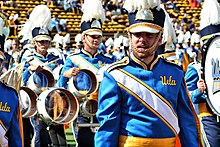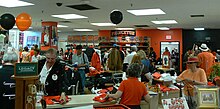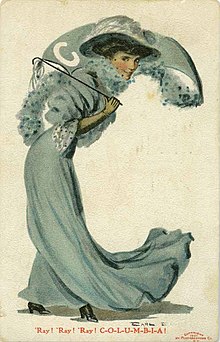School colors

School colors, also known as university colors or college colors, are the colors chosen by a school, academy, college, university or institute as part of its brand identity, used on building signage, web pages, branded apparel, and the uniforms of sports teams. They can promote connection to the school, known as "school spirit," and help differentiate it from other institutions.[1]
Background

The tradition of school colors appears to have started in England in the 1830s. The
Many US colleges adopted school colors between 1890 and 1910. These were generally chosen to be distinctive, something that grew harder as more colors and color combinations were taken, although many Presbyterian colleges chose to imitate Princeton University's black and orange.[5] Some American schools, in a display of patriotism, adopted the national colors of "red, white, or blue."[6]
The most popular colors among US colleges ranked in the 2012 Forbes Top 50 or in the 2012–13 NCAA basketball or cross-country rankings were white, blue, red, black, and gold. These same five colors were the most popular five colors among colleges in each of the three rankings individually.[7]
Sports

The use of colors to identify university sports teams dates back at least to the second
Most competitive teams keep two sets of uniforms, with one emphasizing the primary color and the other emphasizing the secondary color. In some sports, such as American football, the primary color is emphasized on home uniforms, while uniforms for other sports, notably basketball, use the secondary or a neutral color at home, most commonly white. This is done to avoid confusing the two schools' colors.[citation needed]
In addition, various groups that generate support for athletic teams, including
Nicknames
The university color can sometimes become a nickname for the sports program. For example, the Palatinate (Durham) and the African Violet (Loughborough) in the UK,[12][13] and the Harvard Crimson and Cornell Big Red in the US.[14]
Academic dress

School colors are also used in the academic dress of many institutions. The first school color adopted by a university for its academic dress was
Academic scarves
Many British, Irish and Commonwealth universities and some American universities have an
Notable school colors

- Cambridge blue – University of Cambridge
- Carolina blue – University of North Carolina
- Columbia blue – Columbia University
- Duke blue – Duke University
- Eton blue – Eton School
- Oxford blue – University of Oxford
- Palatinate – Durham University
- Yale blue– Yale University
See also
- Gang colors
- Colors (motorcycling)
- Sports uniform
- Varsity letter
- Couleur
References
- ISBN 9781613500699.
- ^ a b "Oxbridge Blue. How to win the varsity match". The Field. April 7, 2015. Retrieved June 11, 2019.
- ^ John Sargeaunt (1898). Annals of Westminster School. Methuen & Company. p. 238.
- ^ a b C. E. Whiting (1932). The University of Durham 1832-1932'. Sheldon Press. p. 141.
- ISBN 978-1-4214-2883-3.
- ^ "History of Penn Colors, University of Pennsylvania University Archives". www.archives.upenn.edu. Archived from the original on June 5, 2016. Retrieved May 11, 2016.
- ^ Haley Omasta; Stacey Hills (2015). "Official College and University Colors: Student Perception vs. Performance" (PDF). Proceedings of the National Conference on Undergraduate Research (NCUR).
- ^ "Colour palette". University of Cambridge. February 28, 2014. Retrieved December 14, 2022.
- ^ "University of Nottingham Sport Brand". University of Nottingham. Retrieved December 14, 2022.
- ^ "Colour". University of Nottingham. Retrieved December 14, 2022.
- ^ Edward Fitzpatrick (July 25, 2019). "RWU Releases New Hawks Logo". UWIRE Text. Gale Academic OneFile: 1.
- ^ Ben King (September 27, 2023). "University Rugby: League champions Loughborough off the mark with battling win over Nottingham". Talking Rugby Union.
- ^ "Women's National League 2023-24 - Fixtures Released!". British Universities and Colleges Sport. July 21, 2023. Retrieved October 15, 2023.
- ^ Dennis J. Zheng (February 4, 2010). "Big Red Contains Crimson". The Harvard Crimson.
- .
- ^ "Academic Regalia". American Council on Education. Retrieved December 8, 2022.
- .
- ^ "A brief history of academic scarves". Study.EU. Retrieved August 3, 2017.
